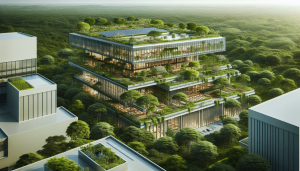Incorporating Renewable Energy Into Building Design
As we strive to create a more sustainable future, one area ripe for innovation is building design. By integrating renewable energy sources like solar panels, wind turbines, and geothermal systems into architectural plans, we can significantly reduce reliance on fossil fuels and minimize the environmental impact of our buildings. This holistic approach not only benefits the environment but also reduces energy costs and increases the self-sufficiency of the structures we inhabit. Let’s explore how we can effectively incorporate renewable energy into the very foundation of our buildings to build a better tomorrow. How can we incorporate renewable energy into building design? It’s a question that more and more of us are asking as we become increasingly aware of the need to live more sustainably. Whether we’re renovating an old home, designing a new office building, or developing a complex urban area, integrating renewable energy sources is a wise choice for both the planet and our wallets.

Understanding Renewable Energy
Before we dive into strategies and solutions, it’s essential to understand what renewable energy is. Renewable energy comes from natural sources that are replenished constantly. Unlike fossil fuels, which are finite and harmful to the environment, renewable energy sources don’t run out and usually have a much lower environmental impact.
Types of Renewable Energy
There are several types of renewable energy that we can consider for our building designs:
- Solar Energy: Harvested from the sun, solar energy is one of the most accessible forms of renewable energy.
- Wind Energy: Captured through wind turbines, this energy is especially useful in areas with consistent wind patterns.
- Hydropower: Generated by the movement of water, usually in rivers or dams.
- Geothermal Energy: Sourced from the heat beneath the earth’s crust.
- Biomass Energy: Produced from organic materials, such as plant and animal waste.
Benefits of Renewable Energy
Incorporating renewable energy into our building designs has numerous advantages:
- Environmental Impact: Reduces greenhouse gas emissions and reliance on fossil fuels.
- Cost Savings: While the initial investment can be high, the long-term savings on energy bills make it worthwhile.
- Energy Independence: Generates power locally, reducing dependency on external energy sources and increasing reliability.
Initial Steps to Incorporate Renewable Energy
Integrating renewable energy into building design is not an afterthought; it’s a fundamental aspect of modern architecture. To make our buildings more sustainable, we must start from the ground up.
Conduct a Feasibility Study
Before diving into construction, it’s critical to conduct a feasibility study to understand the potential for renewable energy integration:
- Assess the Location: Different locations offer different renewable energy opportunities. For example, a site with abundant sunlight would be ideal for solar panels.
- Energy Needs Analysis: Determine the building’s energy requirements to choose the most suitable renewable energy sources.
- Cost Analysis: Evaluate the costs involved in installation, maintenance, and operation versus the long-term savings.
Design with Energy Efficiency in Mind
Energy-efficient design goes hand-in-hand with renewable energy integration. By designing buildings that require less energy, we can maximize the benefits of renewable energy sources.
- Insulation: High-quality insulation reduces heat loss and gain, making climate control more efficient.
- Window Placement: Optimal placement and selection of windows can maximize natural light and reduce heating and cooling needs.
- Building Orientation: The direction our building faces can significantly impact energy consumption, particularly with solar energy systems.
Solar Energy Integration
Solar energy is one of the most popular and versatile forms of renewable energy. Here, we’ll explore how to incorporate it into our building designs effectively.
Types of Solar Technologies
There are two primary types of solar technologies that can be integrated into building design:
- Photovoltaic (PV) Panels: Convert sunlight directly into electricity. These can be installed on rooftops or integrated into building materials such as windows and walls.
- Solar Thermal Systems: Use sunlight to heat water or air for domestic use or climate control.
Installation Considerations
When installing solar panels, several factors need to be considered:
- Orientation: Panels should face south (in the Northern Hemisphere) to capture the maximum amount of sunlight.
- Tilt Angle: The angle of the panels relative to the ground should be adjusted based on latitude for optimal sun exposure.
- Shading: Avoid areas that are shaded by trees or buildings, as this can significantly reduce the efficiency of the panels.
Cost and Incentives
While the initial cost of installing solar panels can be high, various incentives can offset these expenses.
| Incentive Type | Description |
|---|---|
| Federal Tax Credits | A percentage of the installation costs can be deducted from taxes. |
| State Rebates | Individual states may offer cash rebates for solar installations. |
| Net Metering Programs | Excess energy produced can be sold back to the grid, generating income. |
Case Study: Solar-Powered Residential Home
Imagine converting a regular family home into a solar-powered haven:
- Rooftop PV Panels: Install panels on the south-facing roof to generate electricity.
- Solar Water Heater: Use a solar thermal system to heat water for domestic use.
- Energy Storage: Incorporate batteries to store excess energy generated during the day for use at night.
By making these changes, we can significantly reduce the home’s reliance on non-renewable energy sources while enjoying lower energy bills.
Wind Energy Integration
Wind energy can be a fantastic addition to building design, especially for properties located in open, windy areas.
Types of Wind Turbines
There are two main types of wind turbines:
- Horizontal-Axis Wind Turbines (HAWTs): These are the most common type, with blades that rotate around a horizontal axis.
- Vertical-Axis Wind Turbines (VAWTs): These have blades that rotate around a vertical axis and are more suitable for urban environments due to their compact design.
Installation Considerations
Selecting and installing wind turbines involves several key considerations:
- Wind Speed: An average wind speed of at least 10 miles per hour is typically necessary for a wind turbine to be effective.
- Space Requirements: Wind turbines require substantial space to avoid turbulence and maximize efficiency.
- Local Regulations: Check local zoning laws and regulations that might affect the installation of wind turbines.
Cost and Incentives
Like solar energy, wind energy installations can be offset by various incentives:
| Incentive Type | Description |
|---|---|
| Federal Tax Credits | Similar to solar, a percentage of installation costs can be deducted. |
| Production Tax Credits | Offer credits based on the amount of energy produced by wind power. |
| Grants and Loans | Various grants and low-interest loans are available for wind energy projects. |
Case Study: Small Wind Turbine on a Farm
Consider implementing a wind energy solution on a small farm:
- Install a HAWT: Place a horizontal-axis wind turbine in an open area with sufficient wind speed.
- Energy Storage: Use batteries to store energy for times when the wind isn’t blowing.
- Net Metering: Sell excess energy back to the grid to generate extra income.
By adopting wind energy, we can not only reduce our energy bills but also contribute to a more sustainable environment.

Geothermal Energy Integration
Geothermal energy is another fantastic renewable energy source that can be incorporated into building designs, particularly for heating and cooling systems.
Types of Geothermal Systems
Two main types of geothermal systems can be used in buildings:
- Ground Source Heat Pumps (GSHPs): Use the stable underground temperature to heat and cool buildings.
- Direct Use Applications: Utilize geothermal reservoirs to provide heat directly.
Installation Considerations
When considering geothermal energy, several factors need to be evaluated:
- Soil and Rock Composition: The composition of the soil and rock at the site affects the efficiency of the geothermal system.
- Space Availability: Horizontal GSHPs require more land area than vertical systems.
- Permitting: Ensure all necessary permits are obtained before installation.
Cost and Incentives
The costs for geothermal installations can be significant, but various incentives can help mitigate these expenses:
| Incentive Type | Description |
|---|---|
| Federal Tax Credits | Similar to other renewable systems, a percentage can be deducted. |
| State Subsidies | Some states offer subsidies to lower the installation costs. |
| Low-Interest Loans | Special financing options are available for geothermal projects. |
Case Study: Geothermal System in a Commercial Building
Let’s consider implementing a geothermal system in a commercial office building:
- Install a GSHP: Use a ground source heat pump to provide heating and cooling.
- Thermal Storage: Incorporate a thermal storage system to enhance the efficiency.
- Supplementary Systems: Combine with other renewable systems like solar for maximum sustainability.
By adopting geothermal energy, we can significantly reduce our building’s reliance on traditional energy sources while enjoying consistent temperatures year-round.
Hydropower Integration
Hydropower can be a practical renewable energy solution for buildings located near water sources, offering reliable and continuous energy.
Types of Hydropower Systems
There are several ways to harness hydropower:
- Micro-Hydropower Systems: Suitable for generating electricity on a small scale, sufficient for residential or small commercial properties.
- In-Stream Hydrokinetic Systems: Utilize the flow of rivers or streams without the need for large dams.
Installation Considerations
Installing a hydropower system involves several key considerations:
- Water Flow: Assess the water flow and head (vertical drop) to determine the potential energy generation.
- Environmental Impact: Ensure the system has minimal environmental impact, especially on aquatic life.
- Maintenance: Hydropower systems require regular maintenance to ensure optimal performance.
Cost and Incentives
The costs for hydropower installations can be offset by various financial incentives, similar to other renewable systems:
| Incentive Type | Description |
|---|---|
| Federal Tax Credits | A percentage of the installation costs may be deductible. |
| State Incentives | Some states offer specific incentives for hydropower projects. |
| Grants and Funding | Various grants and funding options are available for hydropower projects. |
Case Study: Micro-Hydropower for a Rural Home
Imagine setting up a micro-hydropower system for a rural home located near a stream:
- Install a Turbine: Place a micro-hydropower turbine in the stream to generate electricity.
- Energy Storage: Use batteries to store generated electricity for continuous use.
- Backup Systems: Combine with solar panels as a backup system to ensure a consistent power supply.
By incorporating hydropower, we can make use of natural water flows to generate clean, renewable energy right at our doorstep.

Biomass Energy Integration
Biomass energy is another renewable energy source that can be effectively integrated into building designs, particularly in rural or agricultural settings.
Types of Biomass Systems
There are several types of biomass systems to consider:
- Biogas Systems: Use organic waste to produce biogas, which can be used for heating or electricity.
- Biomass Heating Systems: Employ wood chips, pellets, or other organic materials for heating.
- Combined Heat and Power (CHP) Systems: Generate both electricity and heat from biomass.
Installation Considerations
When installing a biomass system, several factors must be taken into account:
- Feedstock Availability: Ensure a reliable supply of organic materials.
- Storage: Adequate storage space is needed for feedstock and byproducts.
- Permitting: Obtain all necessary permits and ensure compliance with regulations.
Cost and Incentives
Biomass energy systems can also benefit from various incentives to reduce installation costs:
| Incentive Type | Description |
|---|---|
| Federal Tax Credits | A percentage of the installation costs can be deducted. |
| State Programs | Some states offer specific incentives for biomass projects. |
| Agricultural Grants | Various grants are available for farms and rural properties adopting biomass. |
Case Study: Biomass Heating in a Rural School
Consider implementing a biomass heating system in a rural school:
- Biomass Boiler: Install a biomass boiler that uses wood chips or pellets.
- Feedstock Management: Develop a feedstock management plan to ensure a consistent supply.
- Educational Programs: Incorporate biomass education into the school curriculum to raise awareness.
By adopting biomass energy, we can create a sustainable and educational environment while significantly cutting down on carbon emissions.
Combining Multiple Renewable Energy Solutions
To maximize the benefits of renewable energy, it’s often a good idea to combine multiple solutions. This not only increases reliability but also enhances overall efficiency.
Hybrid Systems
Hybrid systems utilize two or more renewable energy sources to provide a more stable and consistent energy supply. For instance, combining solar and wind energy ensures that even if the sun isn’t shining, the wind might still be blowing.
Energy Storage
Energy storage solutions, such as batteries, are integral to a successful renewable energy system. By storing excess energy produced during peak generation times, we can ensure a consistent power supply even during periods of low renewable energy generation.
Smart Grid Integration
Integrating our renewable energy systems into a smart grid allows for better management and distribution of energy. Smart grids can balance supply and demand, reducing energy waste and improving efficiency.
Case Study: Hybrid System in Urban Office Building
Consider a high-rise office building in an urban setting employing a hybrid renewable energy system:
- Rooftop Solar Panels: Install PV panels to capture solar energy.
- Wind Turbines: Place vertical-axis wind turbines on the roof to capture wind energy.
- Battery Storage: Use a battery storage system to manage and store excess energy.
- Building Management System (BMS): Integrate a BMS to monitor and manage energy use efficiently.
This hybrid approach not only ensures continuous power supply but also significantly reduces the building’s carbon footprint.

Conclusion
Incorporating renewable energy into building design is not just a trend; it’s a necessity for a sustainable future. By understanding the various renewable energy sources and assessing the specific needs and conditions of each project, we can create efficient, cost-effective, and environmentally friendly buildings.
Whether it’s solar, wind, geothermal, hydropower, or biomass, each renewable energy source has its unique benefits and considerations. Combining multiple systems and integrating them into smart grids can further enhance the efficiency and reliability of our energy supply.
As we move forward, adopting renewable energy in building design will not only help us meet our energy needs sustainably but also set a precedent for future developments, ensuring a healthier planet for generations to come.



